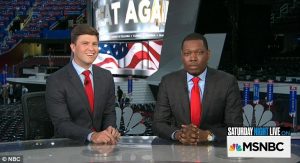Televised Media, Civic Discourse, and the RNC
In 1996, then-President Bill Clinton signed the Telecommunications Act, which was the first significant overhaul of telecommunications law in more than sixty years, representing the first time that the Internet was included in spectrum allotment. The goal was to deregulate converging telecommunications markets in order to foster competition for the new millennium (Miller). In reality, mostly based on its allowance of media cross-ownership, the Telecommunications Act ushered in an age of mergers and acquisitions. In 1983, 90% of US media was controlled by fifty companies. Today, 90% is controlled by just six companies. Six companies control almost all media. That mean that almost all news comes from just six massive conglomerates. This represents an obvious failure of the system. Nowhere was this failure more obvious than during the Republican National Convention.
The Telecommunications Act outlined the licensing of broadcast spectrum to television broadcasters, with one of the main provisions being to work in the public interest. One would think this would mean working as hard as possible to give good news coverage. Instead, broadcast networks entered the RNC woefully underprepared and disinterested in the proceedings. Expecting gaffe after gaffe from the attendees, broadcasters were left with little to say about the convention. Rather than delve into policy, broadcasters reiterated quick sound bites and left investigation to its cable cousins. Cable news has no licensing provision, and makes no pretense that news must bring in ad revenue. As such, they create partisan spectacle.
Broadcast networks, and most pundits, went into the RNC expecting it to be a debacle. However, from the beginning it was going to be a light affair. Many prominent Republicans were skipping, including both still-living former Republican Presidents.

The RNC went pretty smoothly, give or take a Ted Cruz. The event was well organized and, for the most part, unsurprising, regardless of the content conveyed (or stolen). More importantly, it was devoid of chaotic action. This left the networks to make the most out of the circumstances, to create compelling stories. The major network’s job is to make a populace easily distractible care about the news. They were unwilling to do so.
On the RNC’s opening night, CBS appeared to be ready to open their coverage, about to throw to Ivanka Trump’s primetime speech. This was thanks to coordination between the networks and the convention for a 10pm Eastern start. Instead, CBS opened their coverage with some empty platitudes and then decided to squeeze in a commercial break. Anyone tuning into CBS did not see one of the oldest news institutions work in concert with the needs of a large-scale and slow-moving political display, but rather saw Zoe Saldana and a bunch of CGI ships.
It is not surprising that the major networks have fallen out of practise covering such lengthy, stilted events with competency or even enjoyment. Throughout the 2000s, the networks have reduced coverage of the conventions, down to an hour a night, opting instead for advertisements of their own summer programming. This is much to the chagrin of politicos. The networks say that these built-up infomercials do not bring in good ratings. This is hardly a defense, considering that they receive free airwaves worth billions of dollars from the government in exchange for working in the “public interest.” Extensive coverage of the national conventions of the major political parties during the Presidential election would seem like working in the public interest far more than an ad for NCIS.
They paid attention to heavily edited branding and then transitioned to hosts with little to offer besides throwing suddenly to the convention speakers. Without a disaster or major gaffe, they were left with little to wonder at, and had little initiative to debate policy. With so little effort given by broadcast networks, viewers looking for good policy debate were left to wander over to cable. There, one could watch raucous discussions of public policy and speakers’ personalities, all sprinkled with bouts of absurdity.

The problem with cable is that they have no incentive to not be partisan. Being partisan means capturing a market or repeat viewers, and repeat viewers means higher ad revenue. As broadcast networks continue to refuse to offer comprehensive news coverage of such important events as the RNC, people are forced to watch highly partisan cable. Cable whose best interest is bashing other cable news channels to increase viewership. This distorts truth. This moves us into a post-factual world. Bret Stephens, The Wall Street Journal deputy editorial page editor was quoted in the New York Times, “Those who spend an inordinate amount of time “listening to certain cable shows” and inhaling the conspiracy theories promoted on “certain fringes of the internet,’’ he said, wind up in a debate that’s “divorced from reality.” Even influential conservative radio host Charlie Sykes sees a problem. He says, “As a conservative talk show host, one of our themes has always been to bash the mainstream media, to point out the bias. But this is the moment you wake up and you go, O.K., have we done such an effective job that when I say, for example, ‘What Donald Trump said here is demonstrably false and here is the fact-check from The New York Times or The Washington Post’ — we now have an audience that is conditioned to say, ‘Well, you know, that’s the mainstream media, that is the liberal media, I’m not going to take that seriously.’ ” With broadcast focusing more on original programming and cable news channels constantly calling each other liars, there are very media outlets that can act as arbiters of truth. And because of the lack of competition due to the massive conglomerates that own these stations, it’s doubtful that any new outlets will come about.
Miller, Vincent (2011). Understanding Digital Culture. London: SAGE Publications
Comments are closed, but trackbacks and pingbacks are open.